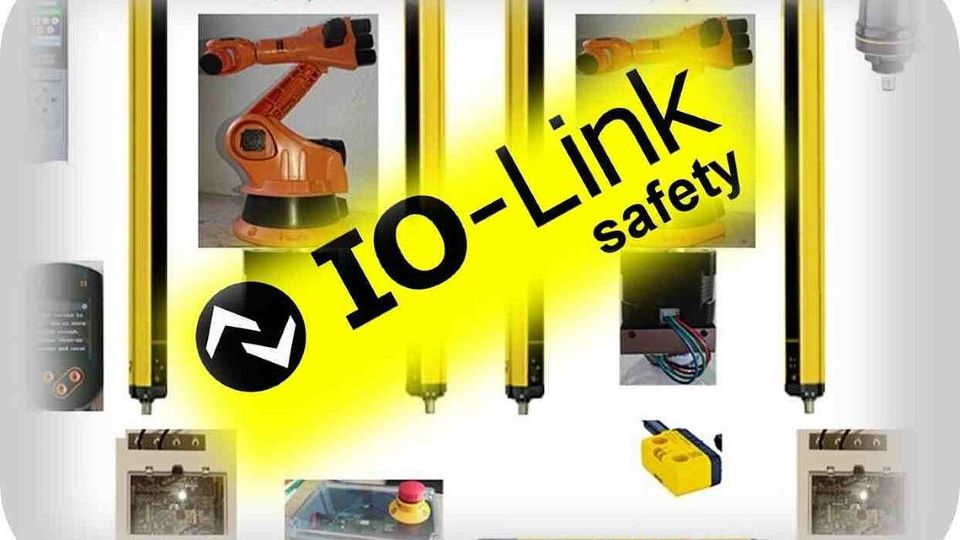 The safety of people, machines, and the environment is the top priority for every system. IO-Link Safety expands IO-Link to include a safe communication layer. As a result, automated machines and systems can now be enhanced with functional safe components and communication through IO-Link as well. IO-Link connection and transmission technology can still be used the same as before – IO-Link Safety devices are still connected to the IO-Link master port with a standard 3- or 5-lead cable. This means that not only versatile safety solutions, but also intelligent diagnostic concepts related to Industry 4.0 solutions, can be implemented.
The safety of people, machines, and the environment is the top priority for every system. IO-Link Safety expands IO-Link to include a safe communication layer. As a result, automated machines and systems can now be enhanced with functional safe components and communication through IO-Link as well. IO-Link connection and transmission technology can still be used the same as before – IO-Link Safety devices are still connected to the IO-Link master port with a standard 3- or 5-lead cable. This means that not only versatile safety solutions, but also intelligent diagnostic concepts related to Industry 4.0 solutions, can be implemented.
Following a successful appearance with a live demo at the 2022 SPS trade fair in Nuremberg (Germany), the IO-Link Community will also be exhibiting the IO-Link Safety multi-vendor demo at the PI Konferenz (March 22-23, 2023 in Frankfurt) and at the Hanover Trade Fair (April 17-21, 2023). All the devices have seen continued development, so even more functions can now be presented during live operation.
Work on the certification of IO-Link Safety has also progressed, and the relevant specifications have been completed. Development work at several companies has continued to the point where the first approved devices can be expected shortly. IO-Link Safety will thus soon see its market introduction, and the IO-Link community is expecting to see a great deal of interest in this new technology on the part of users.
You’ll be able to hear about the latest information on IO-Link Safety in a presentation at the PI Konferenz. Experts will be available for information and discussion at the multi-vendor demo on both days. Naturally, other informative presentations will also be devoted to IO-Link technology at the PI Konferenz, where the agenda will include presentations on IO-Link Wireless, profiles, integration into the world of IT and the use of IO-Link with digital twins and mapping in virtual worlds.
When the IO-Link Safety specification was created, not only was a communication layer defined, but the topic of integration was taken into account and implemented from the get-go as well. As with IO-Link, integration into additional safety bus systems (FSCPs) was specified. With this, an integrated safety system which seamlessly transitions from IO-Link Safety to PROFIsafe, for example, is made available to the user. Since everything’s covered by tested specifications, the user saves both time and money and can get started right away. The topic of integration will also be reported on at the PI Konferenz (www.pi-konferenz.de).
New date for the “IO-Link Safety Certified Designer” training course
 The IO-Link Community is once again offering a training to become an IO-Link Safety Certified Designer in cooperation with TÜV-SÜD from May 09 to 11, 2023. IO-Link Safety expands machines and systems automated with IO-Link to include functionally safe components and communication. The training is held in English in Karlsruhe (Germany) and provides in-depth knowledge of the new technology as well as basic knowledge of safety engineering. After passing the exam, participants receive a personal TÜV certificate.
The IO-Link Community is once again offering a training to become an IO-Link Safety Certified Designer in cooperation with TÜV-SÜD from May 09 to 11, 2023. IO-Link Safety expands machines and systems automated with IO-Link to include functionally safe components and communication. The training is held in English in Karlsruhe (Germany) and provides in-depth knowledge of the new technology as well as basic knowledge of safety engineering. After passing the exam, participants receive a personal TÜV certificate.
On the first day of the course, content will include the basics of IO-Link Safety, such as safety principles, functional objectives, requirements for IO-Link (“black channel”) and risks & remedial measures. Furthermore, the communication protocol, fault detection, device replacement without tools, configuration options & backup, possible architectures, testing & certification, environmental regulations and example applications are covered.
On the second day, TÜV-SÜD will cover the basics of safety development – of FS masters and FS devices in particular – in accordance with IEC 61508/62061 and ISO 13849, enabling participants to evaluate the implications for the engineering departments of their company. This includes an overview of the relevant standards and their content, project management, management for functional safety, required documentation, life cycle, safety functions, preferred architectures, methods for avoiding dangerous faults, FMEA, verification & validation and certification.
The third day will begin with a general overview of procedures for design & implementation and testing as well as the creation of IODDs and dedicated tools. A host of technology and service providers will then present test systems, development kits and development support.
Written tests are administered after the completion of each day’s training. All the tests must be passed in order to receive a certificate. A participation fee of 650 Euros is charged for the course. For more information and online registration, visit www.io-link.com.
